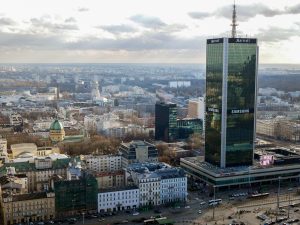Federal Reserve slows pace of inflation rate hikes again but warns of more action ahead
The US central bank has slowed the pace of interest rate hikes further but indicated more rises are likely despite official figures suggesting price pressures have peaked in the world’s largest economy.
The Federal Reserve revealed its verdict hours before counterparts in the UK and Europe made their next moves in the battle against inflation – with both the Bank of England and European Central Bank set to raise borrowing costs further.
The Fed, as it’s known, raised its target interest rate by a quarter of a percentage point – as financial markets expected – following an aggressive set of increases last year to tame decades-high inflation.
It was lifted to a range between 4.50% to 4.75%.
The statement from the Fed confirmed that policymakers planned to maintain an iron grip on inflation risks through further hikes.
“The committee anticipates that ongoing increases in the target range will be appropriate in order to attain a stance of monetary policy that is sufficiently restrictive to return inflation to 2% over time,” it read.
Fed chairman Jay Powell later told a news conference that history told him it would be dangerous to take the foot off the gas “prematurely”.
His language was seen as hawkish in the face of the smallest rise in the target rate since last March though markets, which were initially spooked, took some comfort when Mr Powell confirmed its next moves would be determined by the data.
He also confirmed Fed expectations that the US economy would grow this year.
March 2022 was when the Fed made its first move against surging US inflation as post-pandemic price rises were exacerbated around the world by the war in Ukraine.
The Fed had imposed four consecutive hikes of 0.75 percentage points prior to its last meeting in December, when the pace was reduced to a half percentage point rise.
It was at that point, before Christmas, when inflationary pressures were truly seen by policymakers as easing from the four-decade highs seen earlier in 2022 because so-called core inflation had slowed.
The cost of things such as oil, gas and many other commodities – outside of central bank control – went through the roof.
These increases later became ingrained in prices across Western economies as costs were passed down supply chains, pressuring central banks to cool economic activity and discourage wage increases that could inflame the inflation problem.
While economists believe inflation has also peaked in the UK and across Europe, the continent’s exposure to the loss of Russian energy flows has inflation more stubborn.
The Bank of England is widely expected to lift its rate from 3.5% to 4% on Thursday as a result.
The European Central Bank, which sets the rate path for the 20 countries which use the euro, is expected to impose the same hike in its main deposit rate.
The pound and euro both lost around a third of a cent as the dollar strengthened in the immediate aftermath of the Fed’s decision but both later recovered.
Oil prices, however, were down by 3% as the prospect of more rate tightening was seen as damaging for demand. Brent crude was trading at $83 a barrel.
Richard Carter, head of fixed interest research at Quilter Cheviot, said of the quarter point rate rise: “Investors should not confuse this as the end of the rate hiking cycle, instead a pause for breath as the Federal Reserve looks to continue to fight inflation, while also assessing if further hikes are the way to go.
“The economy has been fairly resilient and the consumer remains in okay shape. Recession could be avoided as a result, but this means we need to prepare for the Fed to continue raising rates for as long as inflation remains elevated.
“The last thing it wants to do is take its foot off the gas too early and stoke a new inflationary cycle,” he wrote.


